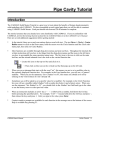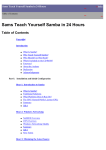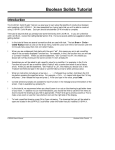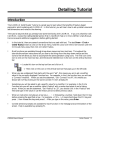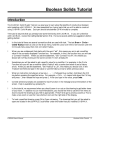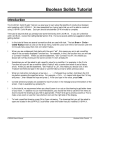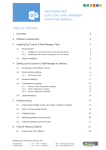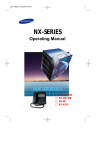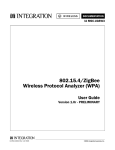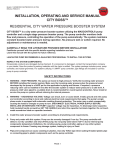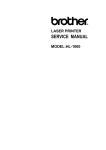Download CADMAX Solid Master
Transcript
Solids Tutorial Introduction The CADMAX Solid Master Tutorial is a great way to learn about the benefits of feature-based parametric solid modeling with CADMAX. We have assembled several typical parts that you will be able to construct using CADMAX Solid Master. Each part should take between 20-40 minutes to complete. The tutorial assumes that you already have some familiarity with CADMAX. If you are unfamiliar with CADMAX, review the Getting Started section first in CADMAX Help or in the CADMAX Users Manual. Here are several additional suggestions before getting started: ! In the tutorial, there are several conventions that are used with text. The text Draw > Circle > Center Radius means to click on the Draw menu, hold the cursor over the Circle function until the Circle sub-menu pops, then click on Center Radius. ! Most functions are available through drop-down menus and icon tool bars. Throughout the tutorials the written instructions tell you how to do things from the drop-down menus and the icons to the left show you how to accomplish the same operation using icons. The first icon is the icon to click on the main tool bar, and the second indented icon is the icon on the vertical function bar. < Locate this icon on the top tool bar and click on it. < Then click on this icon on the vertical tool bar that pops up on the left side. ! When you see a statement that starts with the word “set”, this means you are to set a modifier value in the currently displayed Function box. For example, in the Line function box, you will see a -Connect? modifier. When you see the statement, “Set -Connect? to off”, this means you should set it off by clicking on the word Connect if it isn’t already off. ! Sometimes you will be asked to set a specific value for a modifier. For example, in the Circle Function box you will see a modifier called -Radius? with a combo box below it and a history arrow. When you see the statement, “Set -Radius? to .25”, you should click in the -Radius? text field and type in the value or use the history arrow to select previous value. ! When an instruction includes an arrow key (6 7 8 9) followed by a number, hold down the Ctrl key before pressing the specified arrow. For example, <Ctrl+6>1 means hold down the Ctrl key and press 6, then release the keys and press 1. After you type in the value, press Enter. ! Context sensitive prompts are available for each function in the message area at the bottom of the screen. Help is available buy pressing F1. CADMAX User's Manual Solids Tutorial / 1 ! In the tutorial, we recommend when you should zoom in or out on the drawing to get better views of your work. In addition to our recommendations, you should feel free to use the View menu or the Quick View toolbar to zoom around the drawing as you feel is appropriate. Press F10 to go to previous zooms or F11 to make a new zoom. ! To load a specified drawing, press F4 to Open a drawing. The drawings that you will be asked to open are located in the \SAMPLES sub-folder under the folder that you installed CADMAX. 2 / Solids Tutorial CADMAX User's Manual Bracket The third solid drawing you will model is another bracket as shown in the figure below. This object is constructed in metric. CADMAX User's Manual Solids Tutorial / 3 Opening a Sketch 1. Open the drawing FEATURE_METRIC.CXS from the /SAMPLES folder which is a subfolder under the folder you installed CADMAX. 2. Click on Edit > Feature Modeling or click on the Feature Modeling icon on the Ribbon bar. 3. Click on Edit > Sketch or click on the Sketch icon on the ribbon bar to start a new sketch. 4. In the Work Plane function box, set the -Method? to ‘View’, -Adjustment? to ‘None’ and click on the front view (lower left). Now, no matter which view you work in, as you sketch your object, the geometry will always be oriented to the front view. 5. Click on Draw > Sketch Line on the Sketch function bar. Working in the front view, draw the profile shown using the full view. Use dynamic construction lines to make the lines horizontal and vertical. 6. Click on Draw > Sketch Arc, then click on the end-point of one of the lines, click on a middle point for the arc, then click on the opposite end point to complete the profile as shown. 4 / Solids Tutorial CADMAX User's Manual Adding Dimensions Dimensions are used to make the geometry the desired size. CADMAX does not require that you add dimensions before you extrude the model. You can always return to the sketch and add dimensions or change the sketch later in the design. 1. Click on Dimension > Radial. Click on the arc, drag the cursor to the desired text position and click to place the dimension. Type in 50 and press Enter. This assigns a value of 50 for the dimension and automatically resizes the arc according to the assigned value. You can always change this value at a later time using the Equation function. For example, click on Dimension > Equation then wave the cursor over the radius dimension until it highlights, click on the dimension and type in 35 and press Enter. Click on Undo or press Ctrl+Z to reset the arc radius back to 50. 2. Click on Dimension > Horizontal. Add the dimensions shown in the figure, by placing the dimension and entering its value. 3. Click on Dimension > Vertical. Add the dimension shown in the figure, by placing the dimension and entering its value. CADMAX User's Manual Solids Tutorial / 5 4. Constrain the center point of the R50 arc to the midline of the horizontal 90 length line. Click on Constrain > Connect, wave the cursor over the arc and then click on its center point. Then wave the cursor over the midpoint of the 90 horizontal line until the dynamic construction lines pop-up, click anywhere on the vertical construction line (do not click on the midpoint) The message, “Well-defined; Correct number of dimensions” is displayed. This means that the profile has been fully constrained. Extrude the Profile The first feature in a part is called the base. 1. Click on Feature > Extrude Sketch or click on the Extrude Sketch icon on the top tool bar. The Extrude Base dialog box appears so you can specify the type and distance of the extrusion. 2. Set -Extrude Distance? to ‘44' and -Extrude Extent? to ‘Distance Above’. The extrusion takes place toward the point that you click. The direction of the extrusion is defined by the side of the sketch that you click on. Working in the top view (top left), if you click above the profile, then the extrusion will take place in that direction. Clicking below the profile brings the extrusion toward you. 6 / Solids Tutorial CADMAX User's Manual 3. In the top view, click anywhere below the profile. Notice that: • • • The new feature, Base1, appears in the Feature tree. The top level function bar has changed for Modeling. The sketch was extruded in each view. Set the Display Preferences You change the orientation of a view or how a view is displayed in order to see boundaries that are not visible in a view. The 3D Quick View tool bar on the right side of the screen contains functions to change a view to wireframe, hidden, hidden-dashed, shaded or unshaded. Following are the icons that permit you to change how a view is displayed. To operate these functions, click on the icon, then click on the view to change. Wireframe View Shaded View Hidden View Unshaded View Hidden dashed View To rotate a view, use dynamics. Click on the Dynamic View Roll icon, then click on the view to roll, then click on a roll about point to start the roll. Normally, the roll about point is on geometry in the model. Drag the cursor in the direction of the roll and click again to anchor the view at the new orientation. Use Previous View in the 3D Quick View toolbar to return the view to its original orientation. Dynamic View Roll 1. Previous View Click on Hidden in the 3D Quick View tool bar, then click on the isometric view to make it hidden. CADMAX User's Manual Solids Tutorial / 7 2. Click on Hidden-dashed in the 3D Quick View tool bar, then click on the front, top, and side views to make each view hidden-dashed. 3. If some of the geometry is outside the view window, you can easily pan the window. Click on Dynamic View Move in the 3D Quick View tool bar. Click on the view to move. Then, click on the point to move the view about. Click again to place the view at the new location. The graphic to the right shows the geometry in the top view moved up. Sketch Top Profile In the next series of steps you will sketch a profile of the part looking down on it from the top using the base geometry to constrain the top profile. 1. Click on the Sketch icon on the ribbon bar to start a new sketch. 2. In the Work Plane function box, set the -Method? to ‘View’, -Adjustment? to ‘None’ and click on the top view. It is not necessary to set a depth because the extrude feature will be ‘Through All’ and the depth of the work plane will have no effect. 3. Zoom in on the top view. 4. Click on Draw > Sketch Line. Set -Connect? to ‘on’ and set -Smart Grid? to ‘off’ to turn the dynamic construction lines off. Working in the top view, draw the profile shown. Draw this profile Make sure the end points of the lines aren’t on any geometry. This will assign constraints that will prevent you from drawing this profile correctly. 8 / Solids Tutorial CADMAX User's Manual 5. Click on Draw > Sketch Fillet. Set -Chain? to ‘on’. Note: When -Chain? is ‘on’, then each succeeding fillet after the first fillet will have the same radius as the first fillet and will be constrained equal radius. Assigning a radius dimension to any fillet in the chain will effect all fillets constrained equal radius. Clicking on another function breaks the chain. Click on the top or bottom intersection, drag the cursor toward the center until a fillet echo shows and click to place the fillet. Wave the cursor over the opposite intersection until the fillet echo shows, click once to place the fillet as shown. Fillets Note: When -Chain? is ‘on’, each succeeding fillet only requires a single click since the radius was already defined. If the intersection for a fillet isn’t easy to identify, you can optionally click on the lines or arcs near the intersection. 6. Click on Draw > Sketch Fillet again to restart the chain. Click on the left or right intersection, drag the cursor toward the center until a fillet echo shows and click to place the fillet. Wave the cursor over the opposite intersection until the fillet echo shows, click once to place the fillet as shown. Fillets Note: Using the fillet function constrains the end points of the arcs and line tangent. It is not necessary to explicitly define this constraint. In the next series of steps, you will use the geometry from the base feature to assign constraints to the profile, thereby creating a relationship between them. You are going to make the top and bottom fillets tangent to CADMAX User's Manual Solids Tutorial / 9 the top and bottom edges and then make the fillets concentric. 7. Click on Constrain > Tangent, click on the top fillet, then click on the top edge. Step2: Click on edge Step1: Click on fillet 8. Now repeat the sequence for the bottom arc and the bottom edge. Arcs are tangent to the edges 9. Click on Constrain > Parallel/Concentric and click on the top and bottom arcs to make them concentric. This constraint forces the arc to have a radius equal to one-half the width of the base feature. Arcs have been constrained to be concentric Step 2: Wave cursor over midpoint of line 10. In this step, you are going to constrain the center of the top and bottom arcs to the midline of the base feature. Click on Constrain > Connect, set -Smart Grid? ‘on’, click on the center point of the top or bottom arc, wave the cursor over the midpoint of the horizontal line to display the vertical construction line, click 10 / Solids Tutorial Step1: Click on arc center point Step3: Click anywhere on vertical construction line CADMAX User's Manual anywhere on the construction line (do not click on geometry). 11. Click on Dimension > Radial. Click on the left arc, drag the cursor to the desired text position and click to place the dimension. Type in 12 and press Enter. 12. In the final step, you are going to connect the midpoint of the left and right arcs to the midpoint of the vertical lines on the edges of the base feature. Click on Constrain > Connect, wave the cursor over one of the arcs, click on the midpoint (not the center point) of the arc, then wave the cursor over the corresponding vertical line and click on the midpoint of the line. Repeat this sequence for the opposite arc, completing the profile. Extrude Profile In the next sequence, you will extrude the profile and leave the common elements between the two features. 1. Press F10 or click on Previous in the Quick View tool bar to display the four views. CADMAX User's Manual Solids Tutorial / 11 2. Click on Feature > Extrude Sketch to display the Extrude function box. Select Common as the type of extrude. 3. In the Extrude Boss function box, set: • • • 4. -Target Solids? to ‘All’ -Extrude Extent? to ‘Through All’ -Extrude Distance? is not used Click anywhere to apply the feature. Notice that: • • • The new feature, Share1, appears in the Feature tree. The top level function bar has changed for Modeling. The common elements between the two features has been left as shown. Add a Cylinder Boss 1. Click on the Sketch icon on the ribbon bar to start a new sketch. In the Work Plane function box, set the -Method? to ‘View’, -Adjustment? to ‘Origin’, click on the top view, then in the front, side, or isometric view click on the bottom edge of the part to set the depth of the work plane. 12 / Solids Tutorial CADMAX User's Manual 2. Click on Draw > Sketch Circle. In the top view, wave the cursor over the top or bottom arc, click on the center point of the arc and drag the cursor until the circle snaps to the top or bottom arc, then click to place the circle. This constrains the circle to have the same radius as the arc in the part. 3. Click on Feature > Extrude Sketch to display the Extrude function box. Select Boss as the type of extrude. 4. In the Extrude Boss function box, set: • • • 5. Insert circle -Target Solids? to ‘All’ -Extrude Extent? to ‘Distance Above’ -Extrude Distance? to ‘42' Click anywhere above the object in the front, side, or isometric view to apply the feature. Notice that: • • • CADMAX User's Manual The new feature, Boss1, appears in the Feature tree. The top level function bar has changed for Modeling. The common elements between the two features has been left as shown. Solids Tutorial / 13 Add Fillets Add fillets to the top of the base. 1. Zoom in on the isometric view. In the Quick 3D View tool bar on the right edge of the display, click on Dynamic View Roll, then click on the isometric view, then click on a point in the center of the view as the roll about point. Slowly drag the cursor, moving the model until you can see both sides of the model. Click again to anchor the view. 2. Click on Select > Select Surface. Click on the surfaces shown in the figure. The Select Surface function is used to select only surfaces and their edges. Notice that the surfaces highlight in red as you move the cursor over them, identifying which one will be selected. Once a surface is selected, its boundary will turn yellow and a surface tag will display. 3. Click on Select > Unselect Element. Click on the edges shown in the figure. They will turn back to their original color showing that they are no longer selected. 14 / Solids Tutorial CADMAX User's Manual 4. Click on Feature > Fillet, Fixed. Set -Fillet Radius? to ‘1' and click Finish to apply the fillet feature to the selected edges. 5. In the Quick 3D View tool bar on the right edge of the display, use Previous View to change the isometric view back to its original orientation. Click on Previous View, then click on the isometric view. 6. Click in Previous or press F10 to return back to the four views. Add Support Ribs Add support ribs at an 78 degree angle. The work plane will be parallel to the front view and the depth of the plane will be in the center of the part. Once the rib profile is established, you will use a midplane extrude to apply the feature. 1. Click on the Sketch icon on the ribbon bar to start a new sketch. Set the -Method? to ‘View’ and -Adjustment? to ‘Origin’. Click on the front view, then click on the Center snap icon on the Quick Snap tool bar, wave the cursor over the circle until the work plane echo pops to the center of the large circle, then click to set the depth of the work plane. 2. Zoom in on the front view. CADMAX User's Manual Solids Tutorial / 15 3. Click on Draw > Sketch Line. Working in the front view, draft a profile similar to the one shown in the figure. Profile Start the profile at the intersection of the fillet radius shown in the detail view. Use the same point on the opposite side of the profile. This constrains these points to this position. Detail Detail Snap to top of the fillet radius 4. Click on Dimension > Angular. Click on the bottom horizontal line, then click on the left angular line and click to place the text. Type ‘78' and press Enter to assign an angle of 78 degrees. 5. Click on the right angular line, then click on the bottom horizontal line and click to place the text. Type ‘78' and press Enter to assign an angle of 78 degrees. 6. Click on Dimension > Vertical. Click on the top edge of the profile, then click on the top edge of the model and click to place the text. Type ‘4' and press Enter to assign a vertical distance of 4. 7. Click on Previous or press F10 to zoom out to the 4 model views. 8. Click on Feature > Extrude Sketch to display the Extrude function box. Select Boss as the type of extrude. 16 / Solids Tutorial CADMAX User's Manual 9. In the Extrude Boss function box, set: • • • -Target Solids? to ‘All’ -Extrude Extent? to ‘Midplane’ -Extrude Distance? to ‘4' When -Extrude Extent? is set to ‘Midplane’, then the profile extrudes in both directions from the work plane one half the -Extrude Distance?. 10. Click anywhere to apply the feature. Notice that: • • • The new feature, Boss2, appears in the Feature tree. The top level function bar has changed for Modeling. The ribs have been added as shown. Insert a Hole In the following steps, you will insert a hole in the top of the model a depth of 15. 1. Set the work plane to this face Click on the Sketch icon on the ribbon bar to start a new sketch. In the Work Plane function box, set the -Method? to ‘Face’, -Adjustment? to ‘None’ and click on the top surface of the model. CADMAX User's Manual Solids Tutorial / 17 2. Click on Draw > Sketch Circle. In the top view, wave the cursor over the 22 radius circle, click on the center point of the circle and drag the cursor out, click to place a smaller circle. 3. Click on Dimension > Radial. Click on the circle, drag the cursor to the desired text position and click to place the dimension. Type in 14 and press Enter. 4. Click on Feature > Extrude Sketch to display the Extrude function box. Select Cut as the type of extrude. 5. In the Extrude Cut function box, set: • • • 6. Insert circle -Target Solids? to ‘All’ -Extrude Extent? to ‘Distance Above’ -Extrude Distance? to ‘15' Click anywhere below the work plane in the front view to apply the feature. Notice that: • • • 18 / Solids Tutorial The new feature, Cut1, appears in the Feature tree. The top level function bar has changed for Modeling. The hole has been inserted into the top of the model. CADMAX User's Manual Cut Away Excess In the following steps, you will cut away excess from the bottom of the bracket by inserting a 42 radius circle in the front view using the center point of the 50 radius arc and cutting through the bracket. 1. Click on the Sketch icon on the ribbon bar to start a new sketch. In the Work Plane function box, set the -Method? to ‘View’, -Adjustment? to ‘None’, and click on the front view of the model. 2. Click on Draw > Sketch Circle. In the front view, wave the cursor over the 50 radius arc, click on the center point of the arc and drag the cursor out, click to place a smaller circle. 3. Click on Dimension > Radial. Click on the circle, drag the cursor to the desired text position and click to place the dimension. Type in 42 and press Enter. CADMAX User's Manual Solids Tutorial / 19 4. Click on Feature > Extrude Sketch to display the Extrude function box. Select Cut as the type of extrude. 5. In the Extrude Cut function box, set: • • • 6. Click anywhere to apply the feature. Notice that: • • • 7. -Target Solids? to ‘All’ -Extrude Extent? to ‘Through All’ -Extrude Distance? doesn’t need to be set The new feature, Cut2, appears in the Feature tree. The top level function bar has changed for Modeling. The excess material has been removed from the bracket. This completes the bracket. Save your work. Click on File > Save As or press F3. In the Full Path text entry area, type in the new name for the file and click Save As. 20 / Solids Tutorial CADMAX User's Manual




















